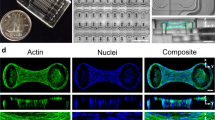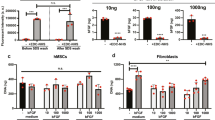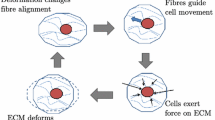Abstract
There is a growing body of work in the literature that demonstrates the significant differences between 2D versus 3D environments in cell morphologies, spatial organization, cell–ECM interactions, and cell signaling. The 3D environments are generally considered more realistic tissue models both because they offer cells a surrounding environment rather than just a planar surface with which to interact, and because they provide the potential for more diverse mechanical environments. Many studies have examined cellular-mediated contraction of 3D matrices; however, because the 3D environment is much more complex and the scale more difficult to study, little is known regarding how mechanical environment, cell and collagen architecture, and collagen remodeling are linked. In the current work, we examine the spatial arrangement of neonatal cardiac fibroblasts and the associated collagen organization in constrained and unconstrained collagen gels over a 24 h period. Collagen gels that are constrained by their physical attachment to a mold and similar gels, which have been detached (unconstrained) from the mold and subsequently contract, offer two simple mechanical models by which the mechanisms of tissue homeostasis and wound repair might be examined. Our observations suggest the presence of two mechanical regimes in the unconstrained gels: an outer ring where cells orient circumferentially and local collagen aligns with the elongated cells; and a central region where unaligned stellate/bipolar cells are radially surrounded by collagen, similar to that seen throughout constrained gels. The evolving organization of cell alignment and surrounding collagen organization suggests that cellular response may be due to the cellular perception of the apparent stiffness of local physical environment.








Similar content being viewed by others
References
Harris, A. K., Stopak, D., & Warner, P. (1984). Generation of spatially periodic patterns by a mechanical instability: A mechanical alternative to the Turing model. Journal of Embryology and Experimental Morphology, 80, 1–20.
Galbraith, C. G., & Sheetz, M. P. (1998). Forces on adhesive contacts affect cell function. Current Opinion in Cell Biology, 10, 566–571.
Huang, S., & Ingber, D. E. (1999). The structural and mechanical complexity of cell-growth control. Nature Cell Biology, 1, E131–E138.
Costa, K. D., Lee, E. J., & Holmes, J. W. (2003). Creating alignment and anisotropy in engineered heart tissue: Role of boundary conditions in model three-dimensional culture system. Tissue Engineering, 9, 567–577.
Bishofs, I. B., & Schwarz, U. S. (2003). Cell organization in soft media due to active mechanosensing. Proceedings of the National Academy of Sciences of the United States of America, 100, 9274–9279.
Watson, S., Burnside, T., & Carver, W. (1998). Angiotensin II-stimulated collagen gel contraction by heart fibroblasts: Role of the AT1 receptor and tyrosine kinase activity. Journal of Cellular Physiology, 177, 224–231.
Kanekar, S., Borg, T. K., Terracio, L., & Carver, W. (2000). Modulation of heart fibroblast migration and collagen gel contraction by IGF-I. Cell Adhesion and Communication, 7, 513–523.
Lee, D. J., Ho, C. H., & Grinnell, F. (2003). LPA-stimulated fibroblast contraction of floating collagen matrices does not require Rho kinase activity or retraction of fibroblast extensions. Experimental Cell Research, 289, 86–94.
Gullberg, D., Tingstrom, A., Thuresson, A. C., Olsson, L., Terracio, L., Borg, T. K., & Rubin, K. (1990). β1 integrin-mediated collagen gel contraction is stimulated by PDGF. Experimental Cell Research, 186, 264–272.
Eleftheriades, E. G., Ferguson, A. G., Spragia, M. L., & Samarel, A. M. (1995). Prolyl hydroxylation regulates intracellular procollagen degradation in cultured rat cardiac fibroblasts. Journal of Molecular and Cellular Cardiology, 27, 1459–1473.
Carver, W., Molano, I., Reaves, T. A., Borg, T. K., & Terracio, L. (1995). Role of the α1β1 integrin complex in collagen gel contraction in vitro by fibroblasts. Journal of Cellular Physiology, 165, 425–437.
Loftis, M. J., Sexton, D., & Carver, W. (2003). Effects of collagen density on cardiac fibroblast behavior and gene expression. Journal of Cellular Physiology, 196, 504–511.
Sawhney, R. K., & Howard, J. (2002). Slow local movements of collagen fibers by fibroblasts drive the rapid global self-organization of collagen gels. Journal of Cell Biology, 157, 1083–1091.
Ehrlich, H. P., Gabbiani, G., & Meda, P. (2000). Cell coupling modulates the contraction of fibroblast-populated collagen lattices. Journal of Cellular Physiology, 184, 86–92.
Borg, T. K., Rubin, K., Lundgren, E., Borg, K., & Obrink, B. (1984). Recognition of extracellular matrix components by neonatal and adult cardiac myocytes. Developmental Biology, 104, 86–96.
Carver, W., Nagpal, M. L., Nachtigal, M., Borg, T. K., & Terracio, L. (1991). Collagen expression in mechanically stimulated cardiac fibroblasts. Circulation Research, 69, 116–122.
Shalitin, N., Schlesinger, H., Levy, M. J., Kessler, E., & Kessler-Icekson, G. (2003). Expression of procollagen c-proteinase enhancer in cultured rat heart fibroblasts: Evidence for co-regulation with type I collagen. Journal of Cellular Biochemistry, 90, 397–407.
Voytik-Harbin, S. L., Roeder, B. A., Sturgis, J. E., Kokini, K., & Robinson, J. P. (2003). Simultaneous mechanical loading and confocal reflection microscopy for three-dimensional microbiomechanical analysis of biomaterials and tissue constructs. Microscopy and Microanalysis, 9, 74–85.
Burrough, P. A. (1981). Fractal dimensions of landscapes and other environmental data. Nature, 294, 240–242.
Bell, E., Ivarsson, B., & Merrill, C. (1979). Production of a tissue-like structure by contraction of collagen lattices by human fibroblasts of different proliferative potential in vitro. Proceedings of the National Academy of Sciences of the United States of America, 76, 1274–1278.
Grinnell, F. (2000). Fibroblast-collagen-matrix contraction: Growth-factor signaling and mechanical load. Trends in Cell Biology, 10, 362–365.
Cukierman, E., Pankov, R., & Yamada, K. M. (2002). Cell interactions with three-dimensional matrices. Current Opinion in Cell Biology, 14, 633–639.
Klebe, R. J., Caldwell, H., & Milam, S. (1989). Cells transmit spatial information by orienting collagen fibers. Matrix, 9, 451–458.
Bromberek, B. A., Enever, P. A. J., Shreiber, D. I., Caldwell, M. D., & Tranquillo, R. T. (2002). Macrophages influence a competition of contact guidance and chemotaxis for fibroblast alignment in a fibrin gel coculture assay. Experimental Cell Research, 275, 230–242.
Barocas, V. H., & Tranquillo, R. T. (1997). An anisotropic biphasic theory of tissue-equivalent mechanics: The interplay among cell traction, fibrillar network deformation, fibril alignment, and cell contact guidance. Journal of Biomechanical Engineering, 119, 137–145.
Kolodney, M. S., & Elson, E. L. (1993). Correlation of myosin light chain phosphorylation with isometric contraction of fibroblasts. Journal of Biological Chemistry, 268, 23850–23855.
Lopez Valle, C. A., Auger, F. A., Rompre, R., Bouvard, V., & Germain, L. (1992). Peripheral anchorage of dermal equivalents. British Journal of Dermatology, 127, 365–371.
Tamariz, E., & Grinnell, F. (2002). Modulation of fibroblast morphology and adhesion during collagen matrix remodeling. Molecular Biology of the Cell, 13, 3915–3929.
Grinnell, F., Ho, C. H., Tamariz, E., Lee, D. J., & Skuta, G. (2003). Dendritic fibroblasts in three-dimensional collagen matrices. Molecular Biology of the Cell, 14, 384–395.
Fringer, J., & Grinnell, F. (2001). Fibroblast quiescence in floating or released collagen matrices. Journal of Biological Chemistry, 276, 31047–31052.
Acknowledgments
The authors thank Cheryl Cook for assistance with cell culture, Dimitri Basilakos and Dr. Robert L. Price for assistance with the confocal microscope, and Timothy Rekers for the bulk mechanical testing. Grant sponsors: NIH HL73937, NSF CMMI 0555329, NIH P20 RR-016461, and USC-SOM Research and Development Fund.
Author information
Authors and Affiliations
Corresponding author
Rights and permissions
About this article
Cite this article
Baxter, S.C., Morales, M.O. & Goldsmith, E.C. Adaptive Changes in Cardiac Fibroblast Morphology and Collagen Organization as a Result of Mechanical Environment. Cell Biochem Biophys 51, 33–44 (2008). https://doi.org/10.1007/s12013-008-9013-8
Received:
Accepted:
Published:
Issue Date:
DOI: https://doi.org/10.1007/s12013-008-9013-8




